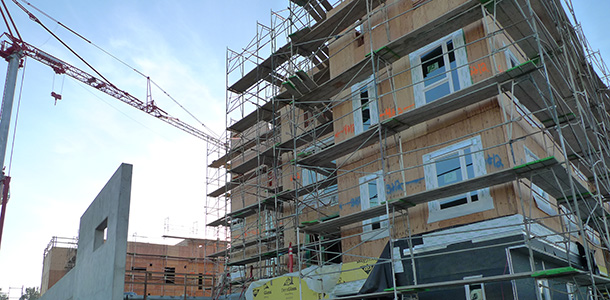
Affordable housing construction in West Sacramento (Photo Credit: Mark Hogan/Flickr)
On most of the major fiscal issues facing California, Gov. Jerry Brown’s revised budget proposal offered a set of familiar arguments last week—about the growing potential of an economic slowdown, about the need for additional contributions into the new Rainy Day Fund, and about the state’s inability to support major new spending. “This is a hold the line effort,” the governor said, noting that the combination of unsteady revenues, rising costs from the new minimum wage, and huge increases in the number of Californians enrolling in Medi-Cal would tie the hands of state government for the foreseeable future.
The governor made only one exception—talking for the first time about the need to respond to California’s growing housing affordability crisis, an issue CA Fwd and its partners in the CA Economic Summit have made a top priority this year. The Summit’s One Million Homes Challenge highlights the need for an “all of the above” strategy to dramatically increase the supply of both affordable and market-rate housing—and produce at least one million more homes over the next decade. Summit leaders are developing a set of fiscal incentives, streamlined local regulations, and CEQA updates that can achieve this goal by encouraging local governments to increase housing development close to jobs and transit.
As recently as January, the governor seemed to shrug off suggestions that the state could—or should—do something about rising costs that are forcing 1.5 million households to spend more than half of their income on rent. But the May Revision offers a much different story, highlighting the administration’s growing awareness of the scope of California’s housing challenges—and, even more importantly, embracing a set of local actions that can reduce costs and increase the supply of housing.
“We need more housing,” the governor said Friday, noting in his budget that communities have approved only 45 percent of the housing needed to meet population and job growth since 2003. He was careful to say state subsidies cannot be the only solution, especially in high-cost cities like San Francisco, where new affordable rental units can cost $500,000 to produce. “We need more production [to] increase supply and bring down the cost,” Brown said. “Otherwise, through subsidies and [local government] restrictions, we’re just spending more and more tax dollars and getting very little.”
In a new section of the budget on “reducing the costs of housing,” the governor has outlined an aggressive collection of state and local actions that align closely with the Summit’s “all of the above” strategy. This includes one major new approach, a proposal to allow “by right” land use entitlements for multifamily infill housing developments that include affordable housing—streamlining the permitting process for housing near jobs and transit. The governor also embraces three bills that promote development of accessory dwelling units, removing local restrictions that prevent homeowners from building—and renting—second units, an approach that has sharply increased housing supply in other cities.
The budget doesn’t make any major new investments in housing, as many advocates have called for, but it does provide some support for low-income families and the homeless—with proposals ranging from setting aside $61 million in existing affordable housing tax credits to redirecting $2 billion in mental health funding to supportive housing services for the homeless and mentally ill.
Will these proposals be enough to bring housing supply back into balance with demand?
As the Summit noted earlier this month in a letter to the Legislature, ideas like these may produce tens of thousands—or perhaps even more than 100,000—housing units. But to adequately house the millions of Californians without access to an affordable home, and to make a dent in the state’s housing undersupply, the state will need to produce at least that many more units each year for a decade.
The governor’s budget, in other words, offers the right framework for addressing this challenge—combining state investment in affordable housing with updates to fiscal, land use, and regulatory policies that stymie all types of housing.
But streamlined permitting is only one piece of this puzzle. More will have to be done to reduce the costs of housing—and to overcome the local obstacles that discourage development.
This is the focus of CA Fwd and our partners between now and the December 13-14 CA Economic Summit. With our sights set on the One Million Homes Challenge, we hope to provide a platform for builders, local governments, advocates, and environmental groups to work together on the rest of the “all of the above” strategy. This will include developing a set of fiscal incentives that encourage local governments to promote housing, offering targeted CEQA streamlining for housing developments close to jobs and transit, and promoting broader local regulatory streamlining, including ideas for reducing developer fees that can add as much as 13 percent to the cost of a house.
The Summit presented some of these ideas this week at the annual meeting of the California Housing Consortium—premiering a video that highlights the coalition forming around the need for a thoughtful, comprehensive solution to the state’s housing challenges.
No single budget or policy proposal can put an end to the state’s housing crisis. By taking on this issue for the first time, though, the governor is providing something that has been lacking until now: State leadership. That is something we cannot do without.

